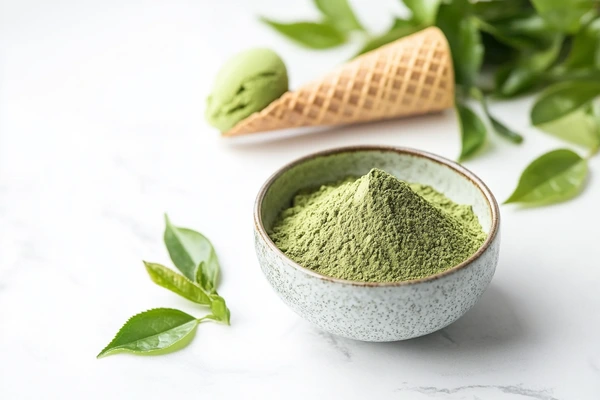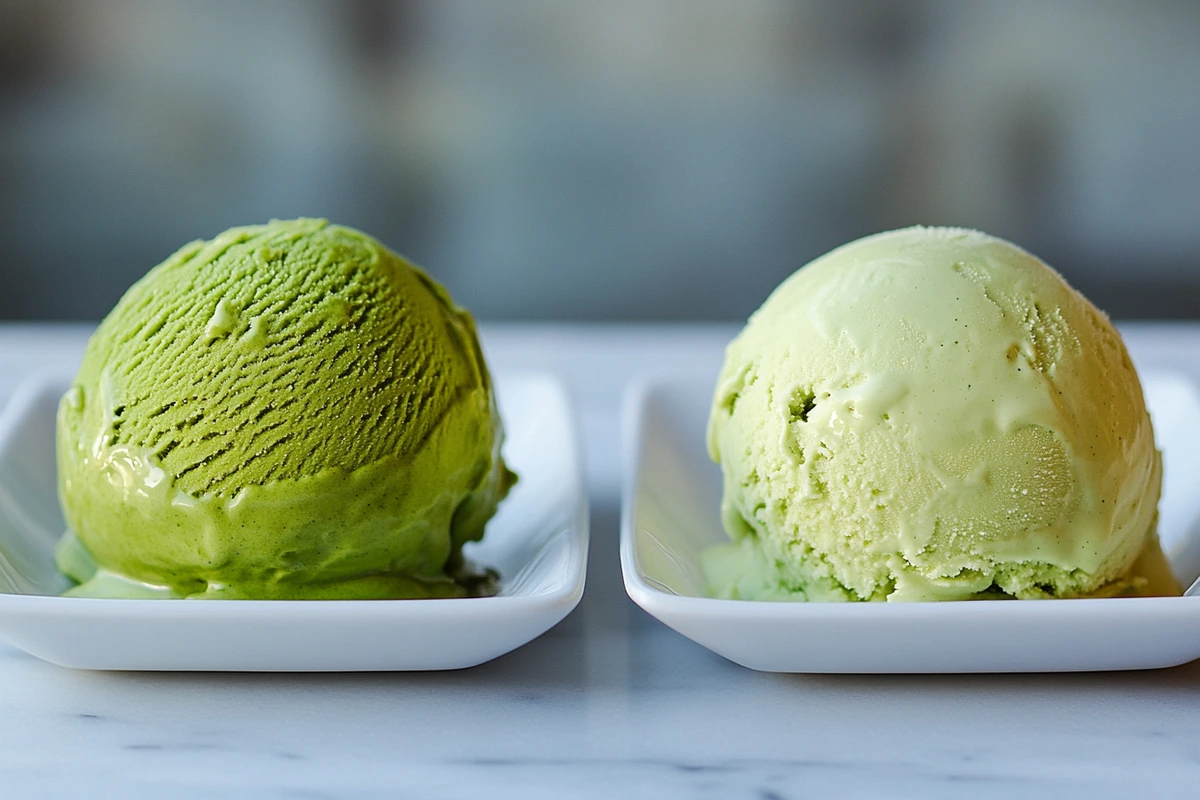When it comes to frozen desserts, matcha ice cream and green tea ice cream often steal the spotlight. While they might look similar at first glance, their taste, ingredients, and preparation set them apart. But how do they really differ? Let’s uncover the truth behind these two beloved treats.
Introduction
Matcha and green tea are often used interchangeably in desserts, but are they truly the same? Both offer a distinctive green hue and a nod to Japanese culture, yet their differences lie in the details. From ingredients to flavor profiles and even health benefits, these two treats provide unique experiences. In this article, we’ll explore the differences between matcha and green tea ice cream to help you understand what sets them apart.
What Is Matcha Ice Cream?
Matcha ice cream delivers a rich and creamy dessert experience by blending matcha powder with dairy or plant-based cream. Chefs create matcha powder by grinding specially grown green tea leaves into a fine, vibrant green powder. This ice cream stands out for its bold, earthy flavor with hints of natural bitterness that balance perfectly with its sweetness.
A Brief History of Matcha in Desserts
Japanese tea ceremonies introduced matcha as a powdered tea centuries ago, but its influence quickly spread into culinary creations. By the late 20th century, matcha began transforming desserts, with ice cream becoming one of its most beloved uses. Japan embraced matcha ice cream as a premium treat, and it soon gained popularity worldwide, especially in cafes and dessert shops that cater to adventurous flavors.
How Do Makers Prepare Matcha?
The process starts with growing tea leaves under shaded conditions. This shading boosts chlorophyll content, giving matcha its signature deep green color and nutrient density. After harvesting, producers steam and dry the leaves, then grind them into a fine powder using traditional stone mills. The resulting powder adds not only flavor but also a silky texture to the ice cream.
People enjoy matcha for its strong, tea-forward flavor and smooth creaminess. Its moderate caffeine content also offers a mild energy boost, making it an excellent choice for tea lovers and dessert enthusiasts alike.
What Is Green Tea Ice Cream?
Green tea ice cream offers a lighter, milder alternative to matcha ice cream. It incorporates green tea as its main flavoring ingredient but often uses leaves or extracts from other green tea varieties like sencha or hojicha, rather than powdered matcha. The result is a dessert with a subtler taste and less intense green color, appealing to those who prefer a gentler tea flavor in their treats.
Types of Green Tea Used
Unlike matcha, which uses finely ground powder, green tea ice cream relies on brewed tea or extracts from green tea leaves. Common varieties include:
- Sencha: Known for its fresh, grassy flavor, sencha offers a lighter and slightly sweet profile, making it ideal for creating a more delicate ice cream.
- Hojicha: This roasted green tea variety brings nutty and caramel-like notes, producing a warm and toasty ice cream flavor.
- Genmaicha: Featuring green tea mixed with roasted rice, genmaicha imparts a mild tea flavor with a unique hint of nuttiness.
These teas provide a range of tastes, ensuring green tea ice cream can vary in flavor depending on the specific tea used.
Flavor Characteristics of Green Tea Ice Cream
Green tea ice cream typically has a smoother and less earthy flavor than matcha ice cream. The tea flavor often feels understated, with a gentle sweetness that allows the creamy texture to shine. Many people find it refreshing and easy to enjoy, even if they’re not accustomed to strong tea flavors.
This ice cream has become popular not only for its taste but also for its versatility. Its lighter flavor pairs well with other desserts, such as mochi or fruit, making it a favorite choice in both traditional and modern recipes.

Matcha vs. Green Tea: Key Differences
Although matcha ice cream and green tea ice cream share some similarities, their differences make them unique treats. The table below highlights their key distinctions:
| Aspect | Matcha Ice Cream | Green Tea Ice Cream |
|---|---|---|
| Main Ingredient | Matcha powder (finely ground tea leaves) | Brewed green tea or green tea extract |
| Flavor Profile | Bold, earthy, slightly bitter | Mild, light, sometimes nutty |
| Color | Vibrant, deep green | Pale green or light brown (depending on tea) |
| Caffeine Content | Higher caffeine content due to concentrated matcha | Lower caffeine, varies with tea type |
| Nutritional Value | Rich in antioxidants like EGCG | Contains antioxidants but in smaller amounts |
| Texture in Ice Cream | Smooth, with a noticeable tea-forward taste | Creamy, with a subtle tea essence |
Visual Differences
Matcha ice cream stands out with its intense green hue, a result of the powdered matcha. In contrast, green tea ice cream often looks lighter, ranging from pale green to even beige if made with roasted teas like hojicha. This difference in color also reflects the varying flavor intensities.
Flavor Profiles
The flavor of matcha ice cream feels bold and distinct, delivering an earthy and slightly bitter kick that appeals to tea enthusiasts. On the other hand, green tea ice cream offers a more delicate taste. It often includes subtle grassy or roasted undertones, depending on the tea used, making it accessible for a broader audience.
By understanding these differences, you can appreciate each dessert’s unique qualities and choose one that suits your palate.
Nutritional Value: Matcha vs. Green Tea Ice Cream
Both matcha ice cream and green tea ice cream offer unique nutritional benefits due to their tea-based ingredients. However, their nutrient profiles differ significantly because of how matcha and other green teas are processed and used in the recipes.
Why Matcha Packs More Nutrients
Matcha is made from whole tea leaves ground into a fine powder, meaning you consume the entire leaf when eating matcha ice cream. This results in a higher concentration of beneficial compounds such as:
- Antioxidants: Matcha is rich in catechins, particularly EGCG (epigallocatechin gallate), known for supporting heart health and reducing inflammation.
- Caffeine: Matcha contains more caffeine than regular green tea, providing a mild energy boost and increased focus.
- L-Theanine: This amino acid in matcha promotes relaxation while enhancing mental alertness, creating a balanced effect.
These properties make matcha ice cream a nutrient-dense dessert choice for those looking to enjoy health benefits while indulging in something sweet.
Green Tea Ice Cream: A Lighter Option
Green tea ice cream, on the other hand, offers a subtler nutritional profile. Since it uses brewed tea or extracts, the nutrient concentration is lower than matcha. It still provides benefits like:
- Antioxidants: Green tea is a good source of antioxidants, though not as potent as matcha.
- Lower Caffeine: It contains less caffeine, making it a gentler option for those sensitive to stimulants.
- Mild Caloric Impact: Its lighter flavor profile often translates to fewer added sugars, depending on the recipe.
Health Benefits Comparison
| Nutrient | Matcha Ice Cream | Green Tea Ice Cream |
|---|---|---|
| Antioxidants | High, due to whole-leaf matcha powder | Moderate, from brewed tea or extract |
| Caffeine | Higher caffeine content | Lower caffeine content |
| L-Theanine | Present in significant amounts | Present in smaller amounts |
Both desserts provide refreshing ways to enjoy the health benefits of tea. Whether you prefer matcha’s robust nutritional punch or green tea’s gentler impact, these ice creams can complement a balanced lifestyle.
Culinary Uses and Global Popularity
Both matcha ice cream and green tea ice cream have made their mark not only as standalone desserts but also as versatile ingredients in various culinary creations. Their unique flavors and cultural significance have propelled their popularity far beyond their origins.
Japan’s Love for Matcha
In Japan, matcha holds a deeply rooted cultural significance. Traditional Japanese sweets, known as wagashi, often incorporate matcha ice cream for its bold flavor and vibrant color. Matcha ice cream frequently accompanies mochi, dorayaki (sweet pancakes), or parfaits layered with red bean paste, whipped cream, and jellies. Japanese chefs embrace matcha for its ability to balance sweetness with an earthy complexity, elevating both traditional and modern desserts.
Green Tea Ice Cream’s Global Reach
Green tea ice cream, with its lighter and milder profile, has become widely popular in Western cuisines. Its refreshing flavor appeals to a broad audience and pairs well with international desserts. Chefs often serve green tea ice cream with fruit salads, waffles, or drizzles of chocolate for a fusion of flavors. Many ice cream brands in Europe and North America now offer green tea ice cream as part of their lineup, catering to the growing appreciation for tea-inspired treats.
Culinary Innovations
Both matcha and green tea ice creams have inspired a wave of creative uses in desserts:
- Ice Cream Sandwiches: Matcha or green tea ice cream between soft cookies creates a satisfying mix of textures and flavors.
- Milkshakes and Smoothies: Blending these ice creams into milkshakes or smoothies adds a creamy and refreshing tea flavor.
- Cakes and Pastries: Matcha ice cream often serves as a topping or filling for cakes, macarons, and tartlets.
Why They’re Loved Globally
The growing popularity of tea-based ice creams reflects a broader trend toward exploring flavors that combine indulgence with subtle sophistication. Matcha’s intense taste and cultural prestige resonate with tea connoisseurs, while green tea’s mild and versatile nature appeals to a broader audience.
Whether served as a simple scoop or incorporated into elaborate desserts, both ice creams continue to capture the hearts and taste buds of dessert lovers around the world.
FAQs
1. Is matcha healthier than green tea?
Matcha ice cream offers more antioxidants and nutrients because it uses whole matcha powder. Green tea ice cream is lighter in nutrients since it typically relies on brewed tea or extracts. However, the healthiness of both depends on added ingredients like sugar or cream.
2. Can I substitute matcha ice cream for green tea ice cream in recipes?
Yes, but expect a stronger, earthier flavor with matcha ice cream compared to the milder taste of green tea ice cream. If the recipe requires a subtle flavor, green tea ice cream might be a better choice.
3. How can I tell if an ice cream uses matcha or green tea?
Check the color and flavor. Matcha usually has a vibrant green hue and bold, earthy taste, while green tea tends to be lighter in color and flavor.
4. Do both types of ice cream contain caffeine?
Yes, but matcha contains more caffeine because matcha powder is highly concentrated. Green tea ice cream has a lower caffeine content due to the brewing process.
5. Can both ice creams be made dairy-free?
Absolutely! Both matcha and green tea ice creams can be prepared using plant-based milk or cream alternatives, making them suitable for those avoiding dairy.
6. Which ice cream is more popular worldwide?
Matcha ice cream has gained more international attention due to its bold flavor and cultural association with Japan. However, green tea ice cream’s milder taste makes it a popular choice for those exploring tea-based desserts.
Conclusion
So, Is matcha ice cream the same as green tea? While they may seem similar at first glance, they offer distinctly different experiences. Matcha, made with concentrated matcha powder, delivers a bold and earthy flavor, packed with antioxidants and nutrients. Green tea, on the other hand, provides a milder and subtler taste, often using brewed tea or extracts from other green tea varieties.
Both desserts celebrate the beauty of tea, each with its own unique charm. Whether you crave the intensity of matcha or the lightness of green tea, these treats promise a delightful way to indulge in the refreshing world of tea-based flavors. For a creative twist, check out this recipe for Matcha Cookies and Cream Ice Cream to explore how matcha can transform traditional flavors into something extraordinary.

